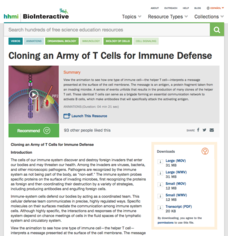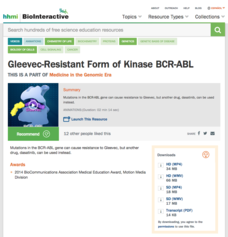PBS
Arthropod Animation: Scorpion Book Gills
Gills extract oxygen from water and send it to the blood stream while removing carbon dioxide and sending it back to the water through these feather-like features. View an animation of scorpion gills, called book gills, by first peeling...
Howard Hughes Medical Institute
Lactose Digestion in Infants
Milk meets every single nutritional need for a baby in the first six months of life. Observe how an infant's small intestine breaks milk lactose down into a usable form of nutrition. With the help of an animation, viewers see the process...
Howard Hughes Medical Institute
Gleevec Inhibits Cancer-Causing Kinase BCR-ABL
Less than 30 percent of those diagnosed with acute myeloid leukemia live for five years. One researcher shares a breakthrough in treatment for this specific type of cancer. He explains how it spreads and how the medication prevents the...
PBS
Sponge Animation: Wild Ride Through a Sponge
Sponges filter many times their body volumes in water every hour with no breaks. Viewers find themselves being swept inside a sponge to observe the filtering process from the inside. They view the canals, the feeding cells, the spicules,...
PBS
Sponge Animation: Spicules
Many people think of sponges as being soft, but that's not the case in the ocean. Viewers learn about the sponge skeleton made of hard crystal material. They observe the many unique shapes and understand how scientists use these shapes...
PBS
Molluscs: Blue-Ringed Octopus Warning Coloration
What animal is only eight inches long and can easily kill an adult human? The blue-ringed octopus changes body color before neutralizing any threat, human or not. Observe the drastic changes to body color in a short video.
PBS
Tour of the Universe
Understanding the size of the universe and its many galaxies challenges perceptions, and this visual journey through the universe helps create a scale. Starting from Earth and going out past our galaxy, thus backwards in time, the entire...
Howard Hughes Medical Institute
Natural Selection of Lactose Tolerance
Different regions of the world have greatly varying rates of lactose tolerance. Learn why this mutation spreads in some populations and not others with an educational video. Viewers consider the relationship with natural selection in...
Howard Hughes Medical Institute
Cloning an Army of T Cells for Immune Defense
How do bodies fight infections and illnesses? An animation of the way T cells clone to fight an infection provides many details. The resource also provides an excellent written introduction and ideas for how to ensure pupils understand...
Howard Hughes Medical Institute
Gleevec-Resistant Form of Kinase BCR-ABL
Gene mutation occurs at a rate much higher than many realize. Doctors treating cancer and other illnesses must learn to adapt quickly after each mutation. Viewers observe an animation and watch lecture with props to see what happens when...
PBS
Ultimate Animal
How do we define the ultimate animal? Is it brain power, athleticism, population size, longest surviving, or something entirely different? Observe many animals at the top of the evolutionary ladder, or more accurately, ladders with a...
PBS
Bilateral Body Plan
Most animals follow a bilateral body plan. The Shape of Life series presents a short video on why this body plan survived across so many different species. The narrator explains the benefits of symmetry, stereo senses, and more....
PBS
Cristina Diaz, Taxonomist: Sponge Biology
Scientists know of almost 10,000 different species of sponges. Listen to a passionate female scientists describe her work as a taxonomist for sponges. She demonstrates an experiment in the ocean off Indonesia and shares her passion for...
PBS
Mollusc Animation: Shell Repair
It often feels like homes need constant work and repairs. Mollusks might feel the same way since they continually repair their shells. A video presents an explanation of how mollusks can survive even a deep crack. Viewers observe the...
PBS
Mollusc Animation: Abalone
Three simple yet functional body parts define mollusks. The Shape of Life series presents an animation of the body plan of a specific mollusk, the abalone. Viewers see the inner workings of the foot, radula, and mantle. They understand...
PBS
Arthropod Animation: Millipede Breathing Tubes
Millipedes breathe through a series of tubes underneath their bodies. A short animation demonstrates the placement and function of these breathing tubes. Scholars build off this knowledge as they learn more about evolution, adaptation,...
PBS
Annelid Animation: Body Plan
Annelids evolved with powerful muscles to dig deep into the ground. Scholars observe the body segments, muscle pattern, unique gut, and the whole body circulatory and nervous systems. Highly detailed animation provides a view of the...
PBS
Nematocyst Animation: Fighting Tentacles
Most species defend their territories, but few use the methods of sea anemones. View a slow motion battle between two enemy anemones fighting for their place on a rock. Scholars apply their knowledge of evolution to consider the intense...
PBS
Cnidarian Animation: Polyp and Medusa
A pencil turned upside down is still a pencil, but a sea anemone turned upside down transforms into a jellyfish. Viewers observe the evolutionary transformation of these cnidarians as they diverged into two distinct body shapes, the...
PBS
Cnidarians: Anemone Catches Goby
Anemones contain harpoon-like structures in their tentacles to attack prey. A video shares an up-close look at an anemone eating a goby. It highlights the attack, capture, and demise of the prey through a system evolved over the course...
PBS
Sponges: Time-lapse of Sponge Cells Recombining
When broken down to a cellular level, sponges reassemble themselves. As the only known plant or animal with this behavior, scientists enjoy watching the process. Scholars view the rebuilding to gain a better understanding of sponges in...
PBS
Sponges: Filter Feeding Made Visible
Sponges must eat to live, yet they don't have mouths. A video series shares how sponges survive using filter feeding rather than traditional eating. It demonstrates how sponges filter water through their entire bodies to extract...
PBS
Molluscs: Octopus Camouflage
A large brain helps the octopus change both color and texture as a form of defense. A video series details the unique features of the mollusks as quick-change artists. It describes the cellular changes and chemical reactions controlling...
PBS
Flatworms: The First Hunter
Flatworms evolved and developed the first bilateral body plan. These hermaphroditic animals with no circulatory system star in an informative video. Scholars learn about flatworms' place in the evolutionary tree, how they hunted, and...























